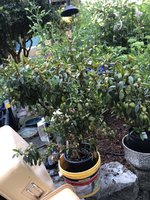Deep Sea Diver
Imperial Masterpiece
Greetings Azalea Folks!
For years BNutter advisors have been sharing information to folks on this site about azalea issues. Specifically concerning leaf signs indicating under and over watering, sun burn and over fertilization. In this thread I decided to experiment to see just exactly what these different issues look look like.
In each trial the set up involves using two nursery satsuki azaleas. The trials were a bit tricky as it was my desire to initiate the initial signs of trouble, yet not to kill the azalea…. to be able to restore it to robust growth. This would yield information on both what the signs were and how to bring the azalea back to a healthy state.
A bit of a sticky tightrope, which proved to be a real challenge.
- An old satsuki cultivar “Beni Kirishima”,

- The second is azalea marketed as a satsuki “Buccaneer”. Buccaneer is supposed to be a Glen Dale hybrid that looks like the flower photo on the left below, but this azalea flowers like the photo on the right. Hmm. Oh well, nursery folks often produce azaleas and just give these catchy names when marketing the plant, without registering it. Maybe this is one of these
Glen Dale Buccaneer Here’s the test subject flower
Here’s the test subject flower 
Anyways these are the two test subjects referred to for each trial in this thread.
Cheers
DSD sends
For years BNutter advisors have been sharing information to folks on this site about azalea issues. Specifically concerning leaf signs indicating under and over watering, sun burn and over fertilization. In this thread I decided to experiment to see just exactly what these different issues look look like.
In each trial the set up involves using two nursery satsuki azaleas. The trials were a bit tricky as it was my desire to initiate the initial signs of trouble, yet not to kill the azalea…. to be able to restore it to robust growth. This would yield information on both what the signs were and how to bring the azalea back to a healthy state.
A bit of a sticky tightrope, which proved to be a real challenge.
- An old satsuki cultivar “Beni Kirishima”,

- The second is azalea marketed as a satsuki “Buccaneer”. Buccaneer is supposed to be a Glen Dale hybrid that looks like the flower photo on the left below, but this azalea flowers like the photo on the right. Hmm. Oh well, nursery folks often produce azaleas and just give these catchy names when marketing the plant, without registering it. Maybe this is one of these
Glen Dale Buccaneer
 Here’s the test subject flower
Here’s the test subject flower 
Anyways these are the two test subjects referred to for each trial in this thread.
Cheers
DSD sends
Last edited:




































